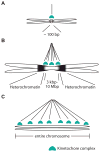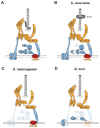Evolutionary Turnover of Kinetochore Proteins: A Ship of Theseus?
- PMID: 26877204
- PMCID: PMC4914419
- DOI: 10.1016/j.tcb.2016.01.005
Evolutionary Turnover of Kinetochore Proteins: A Ship of Theseus?
Abstract
The kinetochore is a multiprotein complex that mediates the attachment of a eukaryotic chromosome to the mitotic spindle. The protein composition of kinetochores is similar across species as divergent as yeast and human. However, recent findings have revealed an unexpected degree of compositional diversity in kinetochores. For example, kinetochore proteins that are essential in some species have been lost in others, whereas new kinetochore proteins have emerged in other lineages. Even in lineages with similar kinetochore composition, individual kinetochore proteins have functionally diverged to acquire either essential or redundant roles. Thus, despite functional conservation, the repertoire of kinetochore proteins has undergone recurrent evolutionary turnover.
Keywords: CENP-B; CENP-T; CenH3; evolutionary dynamics; functional conservation; kinetochore.
Copyright © 2016 Elsevier Ltd. All rights reserved.
Figures



Similar articles
-
Human centromere chromatin protein hMis12, essential for equal segregation, is independent of CENP-A loading pathway.J Cell Biol. 2003 Jan 6;160(1):25-39. doi: 10.1083/jcb.200210005. Epub 2003 Jan 6. J Cell Biol. 2003. PMID: 12515822 Free PMC article.
-
Septin 7 interacts with centromere-associated protein E and is required for its kinetochore localization.J Biol Chem. 2008 Jul 4;283(27):18916-25. doi: 10.1074/jbc.M710591200. Epub 2008 May 6. J Biol Chem. 2008. PMID: 18460473 Free PMC article.
-
CenH3-Independent Kinetochore Assembly in Lepidoptera Requires CCAN, Including CENP-T.Curr Biol. 2020 Feb 24;30(4):561-572.e10. doi: 10.1016/j.cub.2019.12.014. Epub 2020 Feb 6. Curr Biol. 2020. PMID: 32032508
-
The unconventional kinetoplastid kinetochore: from discovery toward functional understanding.Biochem Soc Trans. 2016 Oct 15;44(5):1201-1217. doi: 10.1042/BST20160112. Biochem Soc Trans. 2016. PMID: 27911702 Free PMC article. Review.
-
Mechanisms of kinesin-7 CENP-E in kinetochore-microtubule capture and chromosome alignment during cell division.Biol Cell. 2019 Jun;111(6):143-160. doi: 10.1111/boc.201800082. Epub 2019 Feb 26. Biol Cell. 2019. PMID: 30784092 Review.
Cited by
-
CENP-A nucleosome-a chromatin-embedded pedestal for the centromere: lessons learned from structural biology.Essays Biochem. 2020 Sep 4;64(2):205-221. doi: 10.1042/EBC20190074. Essays Biochem. 2020. PMID: 32720682 Free PMC article. Review.
-
CENP-A: A Histone H3 Variant with Key Roles in Centromere Architecture in Healthy and Diseased States.Results Probl Cell Differ. 2022;70:221-261. doi: 10.1007/978-3-031-06573-6_7. Results Probl Cell Differ. 2022. PMID: 36348109
-
Evolutionary Repair Experiments as a Window to the Molecular Diversity of Life.Curr Biol. 2020 May 18;30(10):R565-R574. doi: 10.1016/j.cub.2020.03.046. Curr Biol. 2020. PMID: 32428498 Free PMC article. Review.
-
Conservation of centromeric histone 3 interaction partners in plants.J Exp Bot. 2020 Aug 17;71(17):5237-5246. doi: 10.1093/jxb/eraa214. J Exp Bot. 2020. PMID: 32369582 Free PMC article.
-
Kinetochore Architecture Employs Diverse Linker Strategies Across Evolution.Front Cell Dev Biol. 2022 Jun 20;10:862637. doi: 10.3389/fcell.2022.862637. eCollection 2022. Front Cell Dev Biol. 2022. PMID: 35800888 Free PMC article. Review.
References
-
- Flemming W. Zellsubstanz, Kern und Zelltheilung. F.C.W. Vogel; 1882.
-
- Rieder CL. The formation, structure, and composition of the mammalian kinetochore and kinetochore fiber. Int Rev Cytol. 1982;79:1–58. - PubMed
Publication types
MeSH terms
Substances
Grants and funding
LinkOut - more resources
Full Text Sources
Other Literature Sources
Molecular Biology Databases

